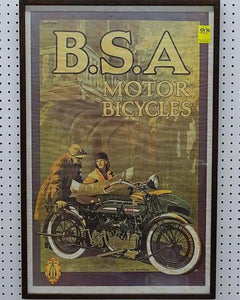
B.S.A. Motor Bicycles Poster, Framed, 1960's.
B.S.A. Motor Bicycles Poster, Framed, 1960's.
What do the Crimean War, the manufacturing of rifles, and the building of bicycles have in common?
They’re all events that led up to the British Birmingham Small Arms Co. better known to the world as BSA producing motorcycles that ultimately became among the most iconic in the world. The legendary brand will be honoured this year as the Marque of the Year at AMA Vintage Motorcycle Days, set for July 24-26 at Mid-Ohio Sports Car Course in Lexington, Ohio.
“Despite its rather unorthodox beginning, BSA endured and carved out an impressive place in motorcycling history,” said Tigra Tsujikawa, marketing, and special events manager for the AMA. “BSA Gold Stars, Shooting Stars, and other models rightfully earned a reputation for performance on the track and played a large role in the brand remaining popular long after the factory shuttered its doors in the 1970s. I’m personally looking forward to showcasing the marque at AMA Vintage Motorcycle Days, and highlighting the machines and people who made BSA famous.”
The Birmingham Small Arms Co. was formed in 1861 by a group of gun makers to supply weapons to the British government during the Crimean War. As the war declined, the company branched out into making bicycles, and by 1903 produced its first experimental motorcycle, along with automobiles. Its first in-house motorcycle appeared in 1910, and a subsidiary, BSA Motorcycles Ltd., was created after the first World War saw the company move back into arms manufacturing for the duration.
Between wars, the company focused on refining its motorcycles into well-regarded, reliable transportation that sold well in England, where BSA boasted that one in four motorcycles on the road was made by their company. From the beginning and throughout its history, BSA made a splash with the evocative names it chose for its motorcycles: Blue Star, Empire Star, Golden Flash, Road Rocket, Spitfire, Thunderbolt, and Lightning are among the most well known.
Perhaps its most famous model was the Gold Star, “born” in 1938 but refined after WWII. It was named after the Gold Star pins awarded to motorcycles that lapped the famed Brooklands track at more than 100 mph, and would ultimately become the bike of choice among England’s young rockers, who stripped them of unnecessary parts and hot-rodded them into café racers.
During the 1950s the company turned to racing, fielding teams in the Junior Clubman class at the Isle of Man TT. By 1956, BSAs made up 53 of 55 entries in the class.
Looking to replicate its sales success with racing in the United States, the factory entered a team of racers in 1954 in the Daytona 200, which, at the time, was held on the beach course. Aboard a mixture of single-cylinder Gold Stars and twin-cylinder Shooting Stars, BSA riders swept the top five places in the race, cementing the brand’s image in the U.S. as a performance machine.
By the 1960s, small, reliable, oil-tight Japanese machines were gaining momentum. To strengthen its position, BSA merged with Triumph and had mild success with its Rocket 3, a three-cylinder bike that shared its engine and drivetrain with the Triumph Trident. Nevertheless, by the 1970s, performance Japanese motorcycles had displaced BSAs in the minds of many motorcyclists.
Following a merger with the Norton Villiers Triumph Group, the combined company stopped producing BSA-branded machines in 1973.
Still, BSAs endure today as both competitive vintage racers and, along with other British brands such as Triumph, staples of the modern café racer culture.
Item Code - SIG15C139EA
Width: 23" Height: 35" Depth: 1" Weight: 4.082 kg





